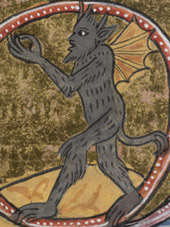 |
 |
 |
 |
 |
 |
 |
|
Fountains Abbey: History
Fountains Abbey: Buildings
|
The monks' choir (9/13) A considerable part of the monks’ day was spent in the church, where they celebrated the Canonical Hours. When numbers peaked in the late twelfth century, about 120 monks would have congregated daily in the choir at Fountains.(21) By the time of the Dissolution in 1539, numbers had fallen significantly and there were only thirty monks. The monks’ choir occupied the crossing and the two easternmost bays of the nave. The monks took their places here in inward-facing wooden stalls. Initially these may simply have been moveable benches, but in the later Middle Ages there were carved wooden stalls, set in stone-lined pits. The monks prayed upright, rather than prostrate, but stood for the night office of Vigils, no doubt to reduce the risk of anyone nodding off. The monk appointed as priest for the week was known as the hebdomadary, and he led the Office. A monastic official called the precentor stood to the right of the choir and led the chant. He and his helper, the succentor (sub-cantor), were responsible for encouraging the singing in choir and making sure that the monks were attentive.
An interesting discovery was made in the nineteenth century, when excavation of the church uncovered pottery vessels embedded in the masonry beneath the choir stalls. It is thought that these were acoustic vases, similar to those used in Roman amphitheatres, to improve resonance and thereby enhance singing in the choir.(22) |
